

With its F-holes and stylized C-bouts it also more closely resembled the viola da braccio. Contemporaneous names for these instruments include " basso de viola da braccio," "basso da braccio," or the generic term " violone," which simply meant "large fiddle." The instrument differed from the violone of the viol, or " viola da gamba" family in that like the other violins it had at first three, and later usually four strings, as opposed to five, six, or seven strings, it was tuned in fifths, and it had no frets. Bass violins were usually somewhat larger than the modern cello, but tuned to the same nominal pitches or sometimes one step lower. They were the direct ancestor of the modern cello. This instrument is somewhat unusual in that it had five strings.īass violin is the modern term for various 16th- and 17th-century bass instruments of the violin (i.e. The preamp also allows active basses to deliver a stronger signal – great if you want to plug straight into the PA or mixing desk.A woodcut of an early bass violin ("Bas-Geig de bracio") from Michael Praetorius' Syntagma musicum, 1619. This extra control means that active basses sound brighter and more snappy than passive ones, which is why they’re often used in funk and metal. These additional electronics typically require extra power, most often found in the form of a 9v battery compartment in the body of the guitar somewhere. Being an older technology, passive basses are typically described as sounding ‘fat’, ‘round’, or even ‘earthy’, making them well suited to rock, blues, and jazz.Īctive basses on the other hand pack in a preamp, sometimes an EQ, and even a compressor to help you sculpt and control your sound more easily. Passive basses require no additional power to be used, working on the voltage generated by your pickups. Whether choosing a four or five-string bass guitar, you’ll also need to pay attention to the electronics and more specifically, whether they’re active or passive. Though rare and often costly, you can get multi-scale bass guitars that have angled frets, allowing you to pack different scale lengths into the same guitar to keep things more compact.

That means that a five-string bass guitar generally has a longer scale length. The rule is that the thicker a string is, the longer the scale length needs to be to ensure the string can sit low enough to the fretboard to remain playable. This is of particular importance because the extra length is a necessity to ensure the additional low string doesn’t flap around or choke out on the fretboard. This relates directly to another important factor, the scale length. So if you’re getting into the world of the five-string bass be prepared to lug some extra weight around with you. Unfortunately, five-string bass guitars require more wood thanks to their longer scale length, larger hardware, and the extra room required for electronics. As huge slabs of wood with massive necks, it’s really part and parcel of the deal.

Lucky for you, here at Guitar World we know a thing or two about getting low, and we're here to ensure you make an informed purchase.īass guitars are heavy.

From the additional weight to the longer scale length, there’s plenty to think about when making a purchase. Buying a 5-string bass guitar can be a minefield if you’re not experienced with the subject.


 0 kommentar(er)
0 kommentar(er)
